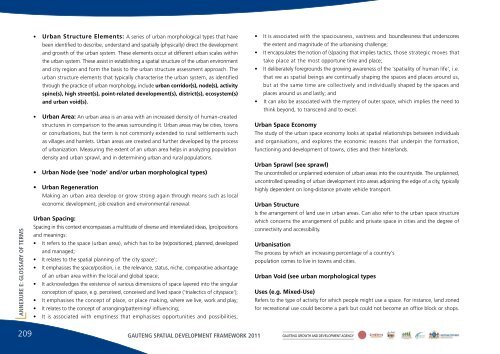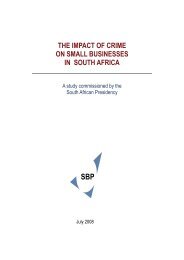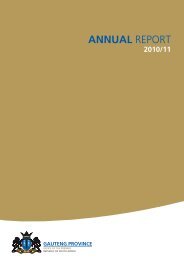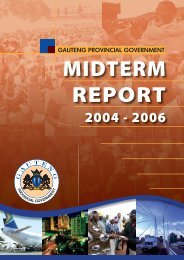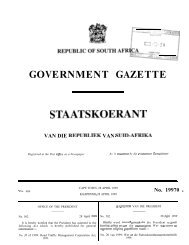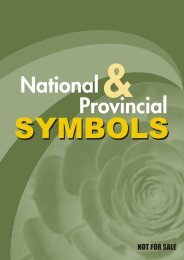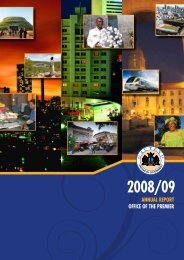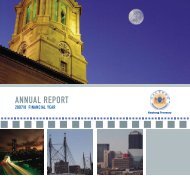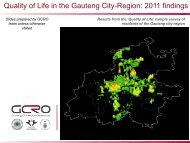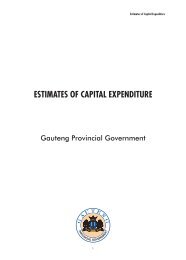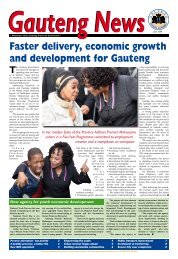the gauteng spatial development framework - Gauteng Online
the gauteng spatial development framework - Gauteng Online
the gauteng spatial development framework - Gauteng Online
You also want an ePaper? Increase the reach of your titles
YUMPU automatically turns print PDFs into web optimized ePapers that Google loves.
ANNEXURE E: GLOSSARY OF TERMS• Urban Structure Elements: A series of urban morphological types that havebeen identified to describe, understand and <strong>spatial</strong>ly (physically) direct <strong>the</strong> <strong>development</strong>and growth of <strong>the</strong> urban system. These elements occur at different urban scales within<strong>the</strong> urban system. These assist in establishing a <strong>spatial</strong> structure of <strong>the</strong> urban environmentand city region and form <strong>the</strong> basis to <strong>the</strong> urban structure assessment approach. Theurban structure elements that typically characterise <strong>the</strong> urban system, as identifiedthrough <strong>the</strong> practice of urban morphology, include urban corridor(s), node(s), activityspine(s), high street(s), point-related <strong>development</strong>(s), district(s), ecosystem(s)and urban void(s).• Urban Area: An urban area is an area with an increased density of human-createdstructures in comparison to <strong>the</strong> areas surrounding it. Urban areas may be cities, townsor conurbations, but <strong>the</strong> term is not commonly extended to rural settlements suchas villages and hamlets. Urban areas are created and fur<strong>the</strong>r developed by <strong>the</strong> processof urbanization. Measuring <strong>the</strong> extent of an urban area helps in analyzing populationdensity and urban sprawl, and in determining urban and rural populations.• Urban Node (see 'node' and/or urban morphological types)• Urban RegenerationMaking an urban area develop or grow strong again through means such as localeconomic <strong>development</strong>, job creation and environmental renewal.Urban Spacing:Spacing in this context encompasses a multitude of diverse and interrelated ideas, (pro)positionsand meanings:• It refers to <strong>the</strong> space (urban area), which has to be (re)positioned, planned, developedand managed;• It relates to <strong>the</strong> <strong>spatial</strong> planning of '<strong>the</strong> city space';• It emphasises <strong>the</strong> space/position, i.e. <strong>the</strong> relevance, status, niche, comparative advantageof an urban area within <strong>the</strong> local and global space;• It acknowledges <strong>the</strong> existence of various dimensions of space layered into <strong>the</strong> singularconception of space, e.g. perceived, conceived and lived space ('trialectics of cityspace');• It emphasises <strong>the</strong> concept of place, or place making, where we live, work and play;• It relates to <strong>the</strong> concept of arranging/patterning/ influencing;• It is associated with emptiness that emphasises opportunities and possibilities;• It is associated with <strong>the</strong> spaciousness, vastness and boundlessness that underscores<strong>the</strong> extent and magnitude of <strong>the</strong> urbanising challenge;• It encapsulates <strong>the</strong> notion of (s)pacing that implies tactics, those strategic moves thattake place at <strong>the</strong> most opportune time and place;• It deliberately foregrounds <strong>the</strong> growing awareness of <strong>the</strong> '<strong>spatial</strong>ity of human life', i.e.that we as <strong>spatial</strong> beings are continually shaping <strong>the</strong> spaces and places around us,but at <strong>the</strong> same time are collectively and individually shaped by <strong>the</strong> spaces andplaces around us and lastly; and• It can also be associated with <strong>the</strong> mystery of outer space, which implies <strong>the</strong> need tothink beyond, to transcend and to excel.Urban Space EconomyThe study of <strong>the</strong> urban space economy looks at <strong>spatial</strong> relationships between individualsand organisations, and explores <strong>the</strong> economic reasons that underpin <strong>the</strong> formation,functioning and <strong>development</strong> of towns, cities and <strong>the</strong>ir hinterlands.Urban Sprawl (see sprawl)The uncontrolled or unplanned extension of urban areas into <strong>the</strong> countryside. The unplanned,uncontrolled spreading of urban <strong>development</strong> into areas adjoining <strong>the</strong> edge of a city, typicallyhighly dependent on long-distance private vehicle transport.Urban StructureIs <strong>the</strong> arrangement of land use in urban areas. Can also refer to <strong>the</strong> urban space structurewhich concerns <strong>the</strong> arrangement of public and private space in cities and <strong>the</strong> degree ofconnectivity and accessibility.UrbanisationThe process by which an increasing percentage of a country'spopulation comes to live in towns and cities.Urban Void (see urban morphological typesUses (e.g. Mixed-Use)Refers to <strong>the</strong> type of activity for which people might use a space. For instance, land zonedfor recreational use could become a park but could not become an office block or shops.209 GAUTENG SPATIAL DEVELOPMENT FRAMEWORK 2011 GAUTENG GROWTH AND DEVELOPMENT AGENCY


